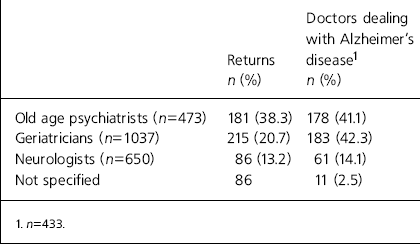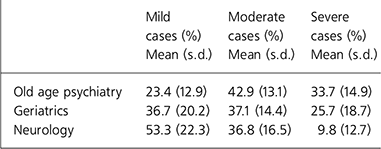In January 2001 the National Institute for Clinical Excellence (NICE) issued its guidelines on the use of donepezil, rivastigmine and galantamine in the treatment of Alzheimer's disease, making these three drugs available for prescription in the NHS (NICE, 2001).
It was decided to survey doctors practising in old age psychiatry, geriatrics and neurology to investigate their working practices before the NICE decision, and their expectations about the effect of the NICE guidance. The intention is to conduct follow-up surveys to investigate the impact of the guidance. Additional surveys were conducted with hospital pharmacists and also with members of health authorities and primary care groups and trusts. This paper presents the results from the baseline survey with clinicians.
Method
The names and addresses of old age psychiatrists, geriatricians and neurologists working in England, Wales, Scotland and Northern Ireland were obtained from various sources including the General Medical Council, journal circulation lists and mailing research representative input. Although NICE guidelines do not apply to Scotland or Northern Ireland, doctors working there were included to obtain information about their current practice.
A questionnaire was designed by the authors and sent to each doctor with a covering letter, a summary of the NICE guidelines and a pre-paid return envelope, shortly after the issue of the guidance. Altogether, 2160 questionnaires were sent out to 473 old age psychiatrists, 1037 geriatricians and 650 neurologists.
Results
Questionnaires were returned by 568 doctors, an overall response rate of 26.3% (Table 1). 135 Respondents did not deal with Alzheimer's disease. The overall response rate may reflect overinclusiveness of the mailing list and the relative importance given to dementia across disparate service provision.
Table 1. Response rates and numbers of doctors dealing with patients with Alzheimer's disease according to speciality

| Returns n (%) | Doctors dealing with Alzheimer's disease1 n (%) | |
|---|---|---|
| Old age psychiatrists (n=473) | 181 (38.3) | 178 (41.1) |
| Geriatricians (n=1037) | 215 (20.7) | 183 (42.3) |
| Neurologists (n=650) | 86 (13.2) | 61 (14.1) |
| Not specified | 86 | 11 (2.5) |
The mean percentage of workload associated with patients with Alzheimer's disease for all three types of doctors (n=433) was 28.1% (s.d. 21.71, range 1-80). The modal averages for old age psychiatrists, geriatricians and neurologists were 50%, 10% and 1% respectively. Answers to the question about the average number of patients with Alzheimer's disease seen per week, given by 353 doctors, ranged from less than 1 to a maximum of 300 (confusion over the wording meant that some doctors reported their case-load). The mean number of patients seen per week by old age psychiatrists was 17.24 (s.d. 31.20) and by geriatricians was 7.90 (s.d. 10.17). Almost half the neurologists indicated that, on average, they see fewer than 1 patient with Alzheimer's disease per week. For the other neurologists (n=30), the mean number of such patients seen per week was 2.43 (s.d. 3.10).
The question about the percentages of mild, moderate and severe cases in their service was answered by 167 old age psychiatrists, 156 geriatricians and 55 neurologists (Table 2). The question of whether old age psychiatrists should now be targeting patients with mild Alzheimer's disease for treatment was answered by 420 doctors. The majority of doctors (85.5%) from the three specialities thought this group of patients should be targeted (88.6% of old age psychiatrists, 83.4% of geriatricians and 83.1% of neurologists). The open-ended follow-up question resulted in some quite different responses. Many of the doctors who did want to target patients with mild disease cited the lack of resources as a hurdle to assessing and treating such patients. There was also some concern about the difficulty of identifying patients with mild disease. Some doctors felt there was insufficient evidence of benefit from cholinesterase inhibitors in mild disease. There were also comments about the fact that patients with mild disease exhibit few symptoms and function well.
Table 2. Percentages of patients with mild, moderate or severe Alzheimer's disease seen within services according to speciality

| Mild cases (%) Mean (s.d.) | Moderate cases (%) Mean (s.d.) | Severe cases (%) Mean (s.d.) | |
|---|---|---|---|
| Old age psychiatry | 23.4 (12.9) | 42.9 (13.1) | 33.7 (14.9) |
| Geriatrics | 36.7 (20.2) | 37.1 (14.4) | 25.7 (18.7) |
| Neurology | 53.3 (22.3) | 36.8 (16.5) | 9.8 (12.7) |
Doctors were asked to indicate their primary method of assessment and treatment for patients with Alzheimer's disease, from the following options:
-
• assess and refer back to primary care with diagnosis and (discharge) plan;
-
• assess and initiate treatment for the general practitioner to follow up (using a shared care protocol);
-
• assess and continue treatment;
-
• see tertiary referrals only;
-
• give details of other approaches used.
Old age psychiatrists were most likely to assess the patients and then continue to treat them (65.1%). Neurologists were most likely to assess the patients and refer them back to primary care with a diagnosis and a plan (41.7%). Geriatricians indicated that they tend either to assess the patient and refer back to primary care with a diagnosis and plan (35.2%), or to use an alternative method of assessment and treatment to the options given (39.8%). Examples of such alternatives were to refer on to an old age psychiatrist, to assess and then involve the community mental health team, or to refer the patient to a memory clinic.
Doctors were asked which type of clinic they had — a dementia clinic, a prescribing clinic, a mixed clinic (containing elements of both) or a memory clinic — and whether they prescribed treatments for Alzheimer's disease in the community (Table 3). Of the doctors who did not already have one of the above clinics, the majority indicated that they intended to establish a memory clinic. Some of the additional services mentioned were a mobile memory assessment team, a memory monitoring service, and a memory clinic to deal with younger people affected by dementia. The time-scale for the establishment of new clinics varied from ‘within the next 2-3 months’ to ‘a year’. Many doctors indicated that they were awaiting funding and would establish new clinics as soon as money became available.
Table 3. Type of clinic provided, according to speciality

| Dementia clinic n (%) | Prescribing clinic n (%) | Mixed clinic1 n (%) | Memory clinic n (%) | Prescribe in the community n (%) | |
|---|---|---|---|---|---|
| Old age psychiatrists (n=166) | 13 (7.8) | 20 (12.0) | 67 (40.4) | 48 (28.9) | 58 (34.9) |
| Geriatricians (n=75) | 6 (8.0) | 3 (4.0) | 25 (33.3) | 33 (44.0) | 9 (12.0) |
| Neurologists (n=29) | 4 (13.8) | 1 (3.4) | 9 (31.0) | 11 (37.9) | 4 (13.8) |
Of the 425 doctors who answered the question about regularly prescribing treatment for Alzheimer's disease, 143 were regular prescribers (33.6%). Nearly 75% of these were old age psychiatrists, 18.2% were geriatricians and 7.0% were neurologists. One hundred and seventy doctors answered the question about why they did not prescribe Alzheimer's disease treatment. The main reason was the unavailability of treatment on the NHS owing to a lack of health authority funding (82.4%); 17.6% of doctors indicated that there was no availability on the NHS owing to their trust having different funding priorities, and 6.5% of doctors did not prescribe the treatments because they did not consider them useful. This mirrors work by Taylor et al (Reference Taylor, Mace and Fry2001), which found that funding for cholinesterase inhibitors was not provided by 52% of health authorities. Only 83 doctors indicated their current annual expenditure on the treatment of Alzheimer's disease: this varied greatly, from £500 to £400 000. The most frequently quoted figures were £10 000 (10.8%), £20 000, £40 000 and £50 000 (all at 9.6%). The population of those over the age of 65 years also varied a great deal: the range was 6300 to 160 000 persons. When asked whether their trust had a policy to prevent discrimination against older patients, 419 doctors responded. There were 103 doctors (24.6%) working in trusts with such a policy, 130 doctors (31.0%) were in trusts with no policy, and 186 doctors (44.4%) did not know whether their Trust had such a policy or not.
There was a high level of awareness about the NICE guidance before the doctors received the summary with the questionnaire: 338 Alzheimer's disease-treating doctors (78%) were already aware of the outcome of the NICE deliberations when they completed the questionnaire. Sources of information included the press (both medical and national), journals, conferences, the NICE website and discussions with colleagues. The guidelines were distributed by some departments and trusts, and in some cases doctors received information directly from NICE. Some doctors had prior knowledge of the NICE deliberations through having submitted evidence to NICE and contributed to the development of the guidance. Almost all doctors (94.2%) answered the question about whether their service would have to change as a result of the NICE decision. Overall, 57.1% of doctors thought that their service would change as a result of the NICE decision. Old age psychiatrists were most likely to think that their service would have to change to accommodate assessment and prescribing to patients with mild disease who customarily would not be seen (69.8%). This was also true for 50.9% of the geriatricians and 43.6% of the neurologists.
Discussion
The majority of the burden of prescribing drugs for the treatment of Alzheimer's disease falls on old age psychiatrists, who paradoxically may have the least resources. To use existing resources effectively will require the agreement of clear protocols among all relevant local services, which incorporate new funding as the NICE guidance is implemented.
The majority of doctors indicated that patients with mild Alzheimer's disease should now be targeted for treatment, yet this is not reflected in current practice. Because old age psychiatrists have traditionally been associated more with the behavioural aspects of the condition, less than a quarter of their cases are in the mild range as they tend to receive referrals later in the illness. The new emphasis will require better information in primary care. Neurologists often see people with milder disease, as subtle disorders and younger patients have been preferentially referred to them. Patients with mild disease are less unwell and perhaps suit the more traditional out-patient/neurological approach for assessment and treatment. The term ‘memory clinic’ can also be helpful, whereas the terms ‘old age’ and ‘psychiatry’ can be off-putting. This suggests that the successful community approach of old age psychiatry might need adapting to encompass this new work.
Early diagnosis and treatment must become the norm in Alzheimer's disease, rather than referral being delayed until behaviour has deteriorated. Services will now have to make a radical change to respond to this, and to implement the NICE guidance.
Declaration of interest
The pharmaceutical companies Janssen-Cilag and Shire met the cost of the administration of this project.






eLetters
No eLetters have been published for this article.